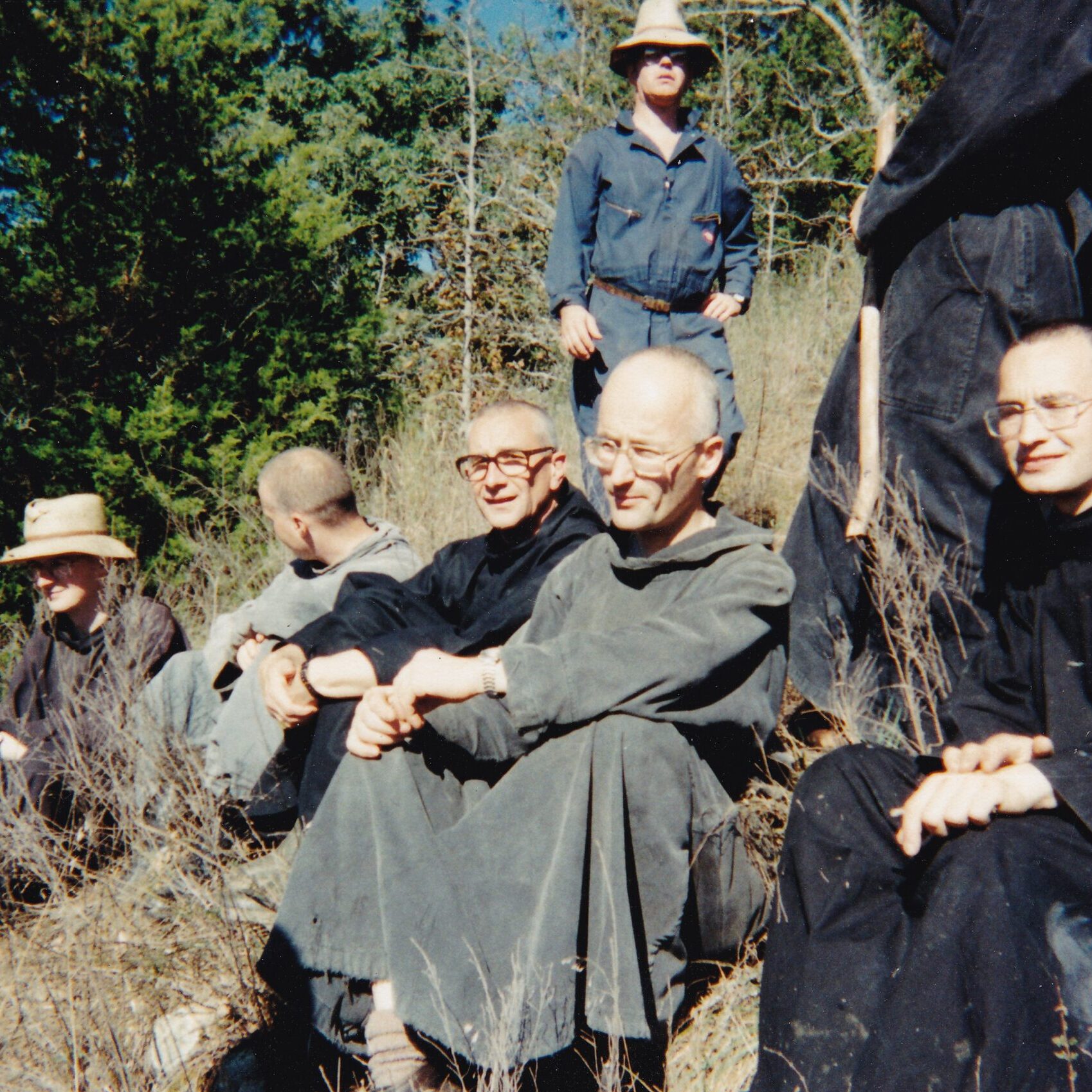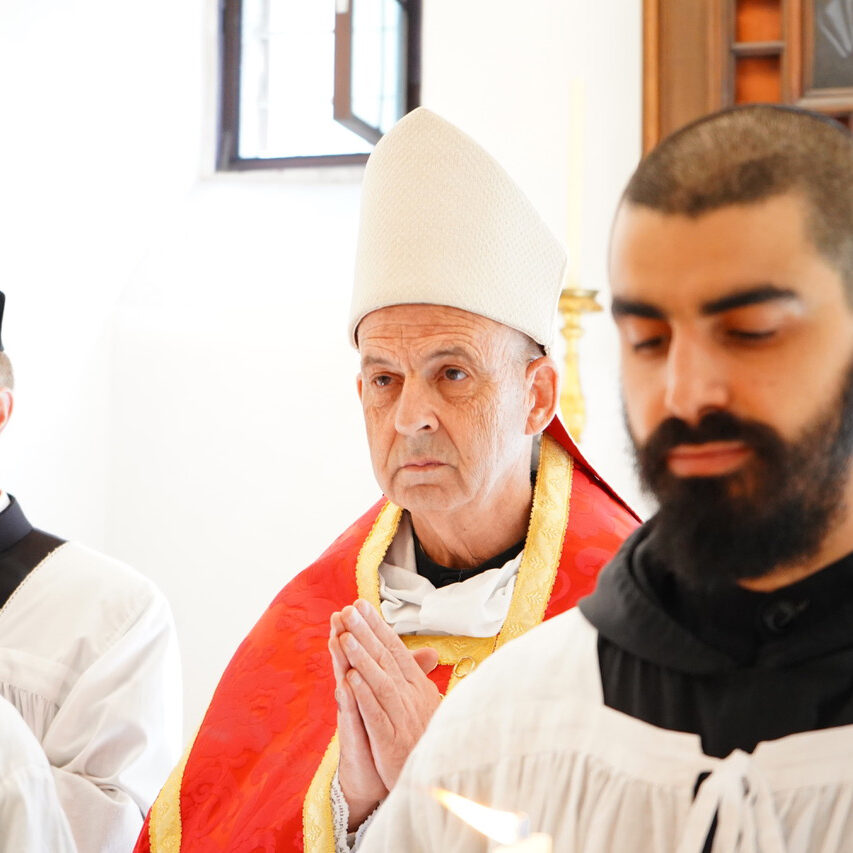Dear Friend of Clear Creek,
The Season of Advent is upon us. Whether we live within the monastery walls or without, it is important to orient our souls right now, so as not to let the hustle and bustle of Christmas preparations steal the spiritual graces that invite us to more spiritual meditations. At this time of year, we must all be contemplatives, at least in spirit.
What better subject could we find for our Advent contemplation — during this Year of the Priest, so proclaimed by the Holy Father — than the relationship between Our Lady and the Priesthood?
The Saints and the Theologians agree that the center and summit of Mary’s existence was to become the Mother of Christ and therefore the Mother of God. The Mother of God… One might safely assume that such a privilege must entirely fulfill the destiny of the Virgin of Nazareth. What more could God ask of her? And yet there is more: the consequences of the Incarnation are an ocean whose depths are never fully fathomed.
In becoming the Mother of Jesus, God Incarnate, Mary also accepted a larger motherhood. She became the mother of the Mystical Body of Christ, of His Church, and of all who embrace the Christian faith. That makes for quite a few children! Now, among these children who find a special place in her Immaculate Heart, there are some who enjoy a particular title to her affection. Without prejudice to the unique love a mother has for each child, there can be a special relationship that enhances that personal love in some special fashion. This is the case with Priests. Mary has a predilection for Priests.
It is a source of wonder to see how Divine Providence interweaves the lives of human beings in unexpected ways. Although mothers cannot become Priests themselves, they alone bear Priests to God and to the world. The mystery of the woman, so passionately debated in our age, finds here a strong source of illumination. The biographers of Saint Pius X recount how, after his Episcopal consecration as Bishop of Mantua, Giuseppe Sarto decided to visit his home town of Riese. He is said to have held out his hand to his mother, exclaiming, “Look, mother, at my beautiful Episcopal ring!” His mother looked at it, then, touching her wedding ring with her wrinkled fingers, she said: “Yes, Giuseppe, it is a beauty, but you wouldn’t have had it if I had not had this one!”
Advent is the time during which we await the coming of the Messiah, who is also the Sovereign Priest and Victim of Sacrifice. In uttering her “Fiat” to the Archangel, Mary entered into this aspect of the destiny of her Son-to-be and accepted those other Priests, who would come after Christ and continue His mission in the world. The Blessed Mary and the Catholic Priest share in this sense a certain common calling, linked to work of Redemption.
One aspect of this common mission that has come to the fore in our age is the combat for Life. Like the Mother of God and every mother who truly accepts her great calling, the Priest is a man who gives life at the baptismal font and who is called to protect human life at every stage of its development. In other times it might have seemed obvious to men of good will that this precious treasure must be protected from every kind of harm. Nobler souls among the pagan peoples recognized this principle of Natural Law, as we see for example in the Hippocratic Oath, handed down from ancient Greece. In our day, however, the great truths about love and life have become obscured; an all-out war is engaged, where the Priest finds himself in the thick of it all.
As the clergy goes, so goes the Church, so goes the world. As never before, perhaps, there is a need for the maternal protection and help of the Blessed Virgin Mary in favor of Priests in every dimension of the Church’s life. Mothers tend to be the ones who take care of the little but important things of daily life. So Mary is there to solve the countless little problems that come with any priestly ministry, if her sons of predilection will only turn to her in prayer, if only they will not forget to be contemplatives, especially during Advent.
What better way to close these Advent reflections than by quoting from the Little Catechism of the Curé of Ars, containing the wisdom of Saint John Vianney whose 150th anniversary (of his holy death) we are celebrating in conjunction with the Year of the Priest?
St. Bernard tells us that everything has come to us through Mary; and we may also say that everything has come to us through the priest; yes, all happiness, all graces, all heavenly gifts. If we had not the Sacrament of Orders, we should not have Our Lord. Who placed Him there, in that tabernacle? It was the priest. Who was it that received your soul, on its entrance into life? The priest. Who nourishes it, to give it strength to make its pilgrimage? The priest. Who will prepare it to appear before God, by washing that soul, for the last time, in the blood of Jesus Christ? The priest — always the priest.
May the coming of Christ, the King and Sovereign High Priest of the universe, give us strength to face the challenges ahead. And if this majesty frightens us a little, let us also learn to trust ever more in God’s mercy. How can we fail to do so, when this High Priest comes to us in the form of a tiny Child in Mary’s arms?
br. Philip Anderson, Prior
Dear Friend of Clear Creek,
The Season of Advent is upon us. Whether we live within the monastery walls or without, it is important to orient our souls right now, so as not to let the hustle and bustle of Christmas preparations steal the spiritual graces that invite us to more spiritual meditations. At this time of year, we must all be contemplatives, at least in spirit.
What better subject could we find for our Advent contemplation — during this Year of the Priest, so proclaimed by the Holy Father — than the relationship between Our Lady and the Priesthood?
The Saints and the Theologians agree that the center and summit of Mary’s existence was to become the Mother of Christ and therefore the Mother of God. The Mother of God… One might safely assume that such a privilege must entirely fulfill the destiny of the Virgin of Nazareth. What more could God ask of her? And yet there is more: the consequences of the Incarnation are an ocean whose depths are never fully fathomed.
In becoming the Mother of Jesus, God Incarnate, Mary also accepted a larger motherhood. She became the mother of the Mystical Body of Christ, of His Church, and of all who embrace the Christian faith. That makes for quite a few children! Now, among these children who find a special place in her Immaculate Heart, there are some who enjoy a particular title to her affection. Without prejudice to the unique love a mother has for each child, there can be a special relationship that enhances that personal love in some special fashion. This is the case with Priests. Mary has a predilection for Priests.
It is a source of wonder to see how Divine Providence interweaves the lives of human beings in unexpected ways. Although mothers cannot become Priests themselves, they alone bear Priests to God and to the world. The mystery of the woman, so passionately debated in our age, finds here a strong source of illumination. The biographers of Saint Pius X recount how, after his Episcopal consecration as Bishop of Mantua, Giuseppe Sarto decided to visit his home town of Riese. He is said to have held out his hand to his mother, exclaiming, “Look, mother, at my beautiful Episcopal ring!” His mother looked at it, then, touching her wedding ring with her wrinkled fingers, she said: “Yes, Giuseppe, it is a beauty, but you wouldn’t have had it if I had not had this one!”
Advent is the time during which we await the coming of the Messiah, who is also the Sovereign Priest and Victim of Sacrifice. In uttering her “Fiat” to the Archangel, Mary entered into this aspect of the destiny of her Son-to-be and accepted those other Priests, who would come after Christ and continue His mission in the world. The Blessed Mary and the Catholic Priest share in this sense a certain common calling, linked to work of Redemption.
One aspect of this common mission that has come to the fore in our age is the combat for Life. Like the Mother of God and every mother who truly accepts her great calling, the Priest is a man who gives life at the baptismal font and who is called to protect human life at every stage of its development. In other times it might have seemed obvious to men of good will that this precious treasure must be protected from every kind of harm. Nobler souls among the pagan peoples recognized this principle of Natural Law, as we see for example in the Hippocratic Oath, handed down from ancient Greece. In our day, however, the great truths about love and life have become obscured; an all-out war is engaged, where the Priest finds himself in the thick of it all.
As the clergy goes, so goes the Church, so goes the world. As never before, perhaps, there is a need for the maternal protection and help of the Blessed Virgin Mary in favor of Priests in every dimension of the Church’s life. Mothers tend to be the ones who take care of the little but important things of daily life. So Mary is there to solve the countless little problems that come with any priestly ministry, if her sons of predilection will only turn to her in prayer, if only they will not forget to be contemplatives, especially during Advent.
What better way to close these Advent reflections than by quoting from the Little Catechism of the Curé of Ars, containing the wisdom of Saint John Vianney whose 150th anniversary (of his holy death) we are celebrating in conjunction with the Year of the Priest?
St. Bernard tells us that everything has come to us through Mary; and we may also say that everything has come to us through the priest; yes, all happiness, all graces, all heavenly gifts. If we had not the Sacrament of Orders, we should not have Our Lord. Who placed Him there, in that tabernacle? It was the priest. Who was it that received your soul, on its entrance into life? The priest. Who nourishes it, to give it strength to make its pilgrimage? The priest. Who will prepare it to appear before God, by washing that soul, for the last time, in the blood of Jesus Christ? The priest — always the priest.
May the coming of Christ, the King and Sovereign High Priest of the universe, give us strength to face the challenges ahead. And if this majesty frightens us a little, let us also learn to trust ever more in God’s mercy. How can we fail to do so, when this High Priest comes to us in the form of a tiny Child in Mary’s arms?
br. Philip Anderson, Prior






